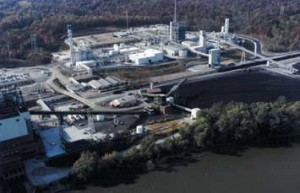“Hydrogen embrittlement is a major cause of fastener failure”
April 30th, 2008
The day before yesterday, the Wabash River IGCC’s pet coke gasifier blew up, or had a majorly pressurized blast (did it ignite? not sure…) that was felt and heard far beyond the plant boundaries. A cover over a flange opening “failed” and it failed while two workers, Danny Turner and David Shoemaker, were tightening bolts 150 feet up in the air. They were killed, and there have not been reports of other workers injured, nor has there been a statement that there were no other casualties, so we don’t know…
Anyway, a little birdie sent me a link, with the hypothesis that hydrogen embrittlement may be related to the failure. Here’s the link:
And here’s the short version, taken directly:
Hmmmmmm, makes sense to me! A quick google brings up a boatload of references, the second one is:
Hydrogen embrittlement of high strength fasteners
The following inspection and management practices associated with bolted connections are recommended:
1. Locate and document all corroded bolted connections during external visual inspections of equipment and piping, especially inspections preceding a scheduled maintenance shutdown. Corroded, high strength fasteners should be replaced during the outage and protected with a barrier coating, anti-seize compound or rust preventative.
2. Incorporate inspection of bolted connections in risk-based inspection management programs.
3. Include provisions in maintenance management procedures to protect newly installed fasteners from corrosion.
So it sounds like the little birdie is on to something here. Google yourself and check it out!
Direct Action!
April 29th, 2008
A couple months ago, I was at my neighbor’s coffee shop, The Galley Room on Main Street in Red Wing, and i saw a stove that looked just like the one I had at 2806 – 12th Ave So., I lived there for three years or so. I really liked it, and the one I have now is so blah, so spur of the moment, I bought it. Then Ann at Ferrin’s had told Deb she wanted to use it for her Christmas window, so there it was for a couple of months, focus of a cute winter scene. Now that we’re back, it was time to have it delivered. So, here it is, and the name, which I hadn’t noticed (it was THAT spur of the moment, name, who cares, I WANT IT!), it’s name is: DIRECT ACTION! How appropriate! So that’s the next project, after the bathroom is up and running, and it looks like the toilet and sink may be functional today. The largest of the bathtub parts arrived UPS today. Soon, though it won’t be next to the window, it has to be on the other side to get the plumbing to it:
More on coal gasification plant explosion
April 29th, 2008
The story of the explosion at the Wabash River coal gasification continues to unfold. The two men killed were identified as Danny Turner and David Shoemaker. Terre Haute News has this report:
================
From a cohort in the know about gasifiers and emissions:
Welcome to the world of high pressure reducing gasification. That’s why I mentioned this possibility before. They call it an “explosion”, but it sounds more like a massive pressure release instead. What’s interesting is that they failed to disclose that while the “roar” continued for “5 minutes”, it was releasing 45-60% CO to the environment. If there had been a temperature inversion and low winds, many more people would have died within the “1/2 mile” radius they checked. MSI has this type of gasifier for DRI,and of course Mesaba I alone would be three to six times larger than Wabash (depends on standby status).
See if you can find out the cause of death of the workers. It might be (instant) CO poisoning (a much more typical accident unless there was a fire too).
================
Emergency response has always been a primary concern of Ron Gustafson, a member of mncoalgasplant.com, my client in our opposition to the Excelsior Energy proposal for the Mesaba IGCC project. He works on emergency response issues professionally, and knows enough about the inherent dangers and probabilities to challenge the adequacy of their plan, equipment, training, and funding for emergency response at the proposed Mesaba Project plant. In this case, the plant was evacuated, local responders were called, and the blast was felt miles away from the plant. We’ll learn more about what happened and what was required of first responders in the coming weeks. It sounds like plant management did all they could in a bad situation. As to causation, I’m wondering what the problem was they were working on, if there’s been a history of corrosion, bolt cracking or similar failures, and then why they were up there in the first place, tightening bolts, indicating that they were loose, when the plant was running.
Coal gasification explosion: metal fitting broke, released gas
April 28th, 2008
Update on the explosion at the Wabash River IGCC coal gasification plant. This article from the Frankfort Times says that a metal fitting broke, pressurized gas leaked and ignited:
Explosion Kills 2 at Indiana Plant That Turns Coal Into Gas
Monday, April 28, 2008
WEST TERRE HAUTE, Ind. (AP) – A leak at a plant that turns coal into gas in western Indiana caused an explosion that killed two workers Monday, authorities said.
The explosion at the SG Solutions coal gasification plant occurred just before 11 a.m. when a metal fitting broke and released pressurized gas, plant manager Richard Payonk said. The gas ignited immediately.
Production at the plant stopped immediately after the explosion pending an investigation.
The workers who died were employees of Evansville, Ind.-based Sterling Boiler & Mechanical Inc. Payonk said about 15 to 20 Sterling employees work at the facility each day, and many are from the Terre Haute area.
The victims’ identities were being withheld pending notification of next of kin, Payonk said.
Sterling Boiler Controller Ken Wahl declined comment Monday beyond a company statement. In it, Sterling Boiler officials acknowledged the accident and offered condolences to the workers’ families.
Payonk said it is too early to know what might have caused the leak.
‘We will determine the nature of the failure and what occurred,’ he said. ‘And we will put corrective actions in place based upon what we can find.’
Wabash River IGCC plant explodes, two workers killed
April 28th, 2008
.
Thanks to John Blair for sending around this head up about the coal gasification plant at Wabash River … more as it appears. Looks like a gasifier blew. This one has a video too:
Explosion at SG Solutions in Terre Haute
Posted: April 28, 2008 10:21 AM
Updated: April 28, 2008 05:14 PM
VIGO COUNTY, Ind. (WTHI) – Just before 11 a.m. Monday an explosion at the SG Solutions Coal Gasification Plant killed two people. Black smoke poured from the plant which is located near the Duke Energy power plant in northwestern Vigo County off of State Road 63.
Ed Utterback, who lives near the plant told News 10 “I’ve lived here since 1957 and I’m accustomed to the power plant periodically blowing down the boilers and it sounds like steam being released… [T]oday it sounded much louder with a little bit of rumble to it and lasted much longer, maybe a minute and a half or two minutes.”
Power plant officials say two men from Sterling Boiler Local 374 were working on an opening of one of the gasification units when it opening exploded. The men were said to be tighting bolts from nearly 150 feet in the air when the explosion occurred.
Richard Payonk, the plant manager of SG Solution announced in an afternoon press conference “To our knowledge they were tightening bolts on this particular flanged opening on the gasifier. Beyond that, I would be speculating on what occurred and how it occurred, except that we do know in hindsight that the opening did fail and come off, yes.”
Parts of the plant were immediately shut down as rescue crews raced to the scene. According to the Vigo County Sheriff’s Department, the fire from the explosion was out before fire crews ever arrived.
The names of both men killed in the explosion have not been released yet, pending notification of family.
John Sisco, a man who says he knew both victims, expressed his anguish to News 10. “What can you say? There’s nothing you can say. It’s just tragic and so sad. These guys were top notch, Grade A boilermakers,” Sisco said. “Great people, great people to be around. And it’s just tragic. It’s a tragic loss and it’s a shame that it happened.” Sisco wanted folks to know “The prayers of every single worker at this facility are with them entirely. These were our close friends as well and we feel we’ve lost family members as well here very much so. It’s a very sad day for that.”
Federal state and local officials are still investigating the exact cause of the explosion. Hamilton Center sent counselors to the power plant to help workers deal with the accident.
By: Joe Stoll and Susan Dinkel WTHI-TV
======================
Production at coke gasification to resume after investigation
Press Release
TERRE HAUTE, IND.—SG Solutions plant manager, Richard Payonk, addressed the media this afternoon following a fatal accident at its pet coke gasification plant in Terre Haute, Ind. Two contractors employed by Sterling Boiler & Mechanical, Inc. were killed.
The accident occurred at SG Solutions just before 11 a.m. today when a flanged opening on a high pressure vessel containing synthetic gas failed. Federal, state and local officials have been notified, and the investigation is ongoing. There is no danger to those nearby the plant.
“The safety of our workers and contractors is our top concern, and we’re vested in working with officials to find the cause of the accident and to make sure we’ve done everything in our power to prevent future accidents from occurring,” plant manager, Richard Payonk said.
Sterling Boiler Controller Ken Wahl issued a written statement this afternoon stating: “Sterling is assisting local authorities in every way possible in determining the cause of the explosion,” the statement said. “Our hearts and prayers are with the families of these individuals.”
Production at the plant stopped immediately following the incident and will resume once an investigation is concluded and all safety procedures are evaluated. Prior to today’s incident the facility had experienced no fatalities since opening in 1995. Wabash Valley Power owns 50 percent of SG Solutions, which operates the gasification plant that transforms petroleum coke into synthetic natural gas.
Wabash Valley Power is a generation and transmission cooperative (G&T) headquartered in Indianapolis. The G&T provides wholesale electricity to 28 electric distribution cooperatives in Indiana, Illinois, Michigan, Missouri and Ohio. Collectively, they serve more than 350,000 homes, farms, businesses and industries. SG Solutions is a national leader in the development of synthetic gas for use in the generation of electricity for homes and businesses.
As one of only two Integrated Gasification Combined Cycle (IGCC) facilities in the United States, SG Solutions has received national recognition as a flagship project of the Department of Energy Clean Coal Program. Source: SG Solutions



